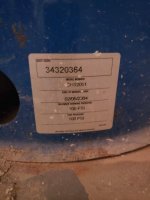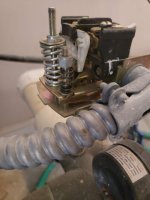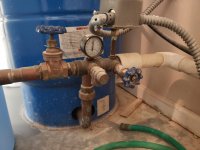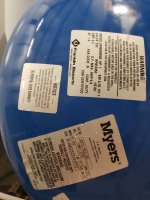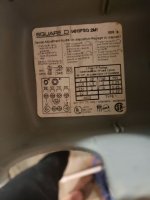bearsbeets
New Member
Hi, I recently (last week) moved in to a temporary new home with a well water system. I'm having issues with water pressure throughout the house and have watched countless videos on pressure tanks/switches/well systems and performed basic upkeep maintenance but am still having pressure issues:
System information:
Tank: Amtrol Champion CH12051
https://www.supplyhouse.com/Amtrol-CH12051-CH-62-62-Gal-Champion-Vertical-Stand-Well-Tank
https://www.rcworst.com/Franklin-El...tor-4-1HP-230V-2-Wire-Single-Phase-p2326.html
Pump: Myers 2NFL102-20-P4 Submersible Stainless Steel Pump
https://www.rcworst.com/Myers-2NFL1...M-1-0-HP-230V-2-Wire-Single-Phase-p14560.html
Pressure Switch: Square D 9013FSG2m1 30-50
https://americangranby.com/PDFs/S01P053.pdf
When the water tank refills to ~65 PSI, pressure in all faucets is great. However, the pressure in the tank drops (as indicated by watching the pressure gauge) to below 55, the pressure in the faucets is greatly reduced. Therefore, from 65 - 55 pressure everything is great and dandy, but then from 55-40 until the pump kicks on again everything is not so great.
Please see photos of the system and components attached to this thread.
System information:
Tank: Amtrol Champion CH12051
https://www.supplyhouse.com/Amtrol-CH12051-CH-62-62-Gal-Champion-Vertical-Stand-Well-Tank
- Date of Manufacture: 02/05/2004
- Max working pressure: 100 PSI
https://www.rcworst.com/Franklin-El...tor-4-1HP-230V-2-Wire-Single-Phase-p2326.html
Pump: Myers 2NFL102-20-P4 Submersible Stainless Steel Pump
https://www.rcworst.com/Myers-2NFL1...M-1-0-HP-230V-2-Wire-Single-Phase-p14560.html
Pressure Switch: Square D 9013FSG2m1 30-50
https://americangranby.com/PDFs/S01P053.pdf
- Stock PSI range: 30 - 50 PSI
- Sq. ft. = 3,600
- Floors = 3 (including basement)
- # bedrooms = 4
- # bathrooms = 4.5
- Cycled through well water tank to see what the cut in and cut off pressures were. Resulting values were 38 - 70 PSI. Given low water pressure as the driver of my adjustments, I wanted to set this range at 40 - 60 (despite stock indicator on pressure switch of 30 - 50).
- Drained well water tank completely and tested air pressure. The reading said 9 PSI. I filled this up to 38 PSI (2 PSI below desired range of 40 - 60)
- Refilled well water tank with water. Tightened the big spring in the pressure switch to increase the cut in value to 40. I loosened the differential (smaller) spring until the spring had no more tension to it, and that reduced the cut out pressure to 65. This leaves a total differential of 25 PSI.
When the water tank refills to ~65 PSI, pressure in all faucets is great. However, the pressure in the tank drops (as indicated by watching the pressure gauge) to below 55, the pressure in the faucets is greatly reduced. Therefore, from 65 - 55 pressure everything is great and dandy, but then from 55-40 until the pump kicks on again everything is not so great.
Please see photos of the system and components attached to this thread.

